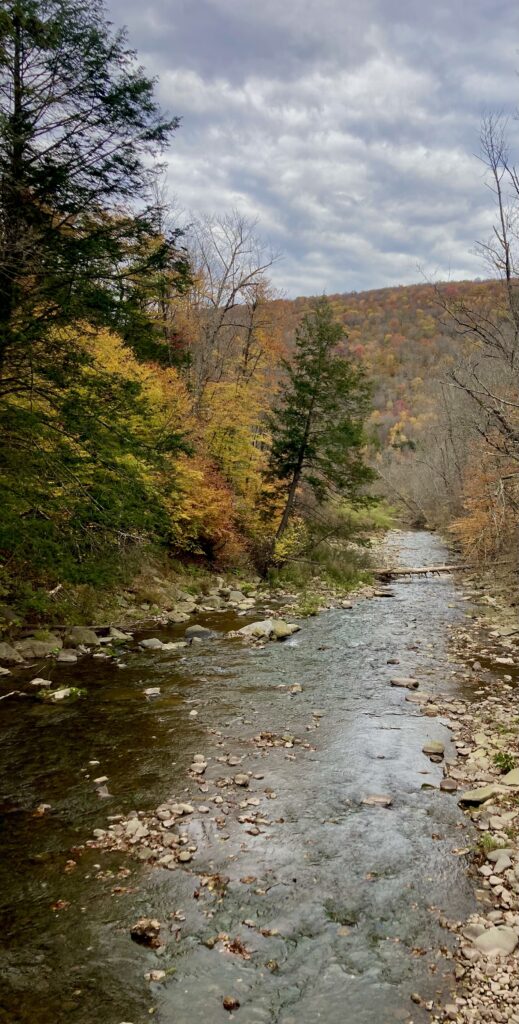Autumn Adventures in the Catskills
Hats off to campers, whom I both admire and aspire to be more like. But I’m not. I’m too old and achy to sleep on the ground by choice. I’ve had my share of camping trips, most enjoyably by the banks of a running river which lulled me to the land of dreamy dreams; most notably in the Outback of Australia wedged between my father and our hunting guide after dining on wild iguana when stranded all night by a broken-down truck; and, most miserably, on the Apawamis Club golf course with a hundred children, listening to I-95 and airplane traffic all night.
I bought my trusty pup tent in the Green Mountains of Vermont on my first solo road trip out of the city when I lived there in the ’90s. When I returned, I set it up in my teensy apartment and lived in it for a week, reading by camping lantern and drinking beers which I could reach in the fridge from my tent. (This is how I knew it was time to move to Texas.) I’ve since pitched it in campsite shelters when it was raining and motel rooms just for fun. Don’t let my tales fool you: I’m not THAT outdoorsy.






Adventurous by day, warm and cozy by night is my M.O. Glamping is appealing…a brilliant idea…but I now prefer my own bed or one in the most expensive hotel I can afford. So, it stands to reason that when planning my recent autumnal pilgrimage to the Catskills and reading that the section I chose to explore offered five lean-tos for overnight campers, I immediately booked a room at Urban Cowboy Lodge…in the Big Indian Wilderness. The two seemed to go hand-in- hand.
Big Indian Wilderness is a tract of 33,860 acres in the township of Shandaken in Ulster County in the Catskill Forest Preserve. It contains the longest stretch of trail through uninterrupted virgin forest in the Catskills range — 22,280 acres of Big Indian (about 66 percent) is “first-growth” forest, meaning it is unaltered by logging, burning, agriculture, mining, or any other manmade action. It’s a rugged, mountainous landscape marked by deep glacial cuts which carved out steep-sided hollows and elevations ranging from 1,500 to 3,860 feet. Balsam, Fir, Haynes, and Eagle peaks are the most prominent. It’s home to the headwaters of rivers offering some of the finest fly fishing in the state: Esopus Creek, the Beaverkill, the Neversink, and the Willowemoc.
Most interestingly it is also part of the homelands of the Munsee Lenape peoples and derived its name from a Munsee man named Winnisook which means “snowfall.” He was called “Big Indian” as he stood at around seven feet in height, was strong, well-built, and reportedly fearless. He fell in love with one of the Huguenot settlers in the area, Gertrude Molyneux, who loved him too but was betrothed to a Dutch settler of questionable character named Joseph Bundy. After a brief and unhappy marriage to Bundy, Gertrude eloped with Winnisook to his village in the wilderness where they settled down and had a family. The story varies from here. By some reports, Winnisook led a livestock raiding party against the Dutch farmers in the area which led to a search party for the missing cattle and sheep. Other reports say the party was simply searching for a missing cow. But it’s a fact that Bundy was part of the party and shot Winnisook with a rifle, leaving him for dead. The mortally wounded man took refuge in a hollow tree (some say pine; some oak) and breathed his last. After his burial, Gertrude and their children moved to be near his gravesite, and the hamlet of Big Indian developed around them. There is a beautifully carved wooden statue of him guarding the entrance to Big Indian Park.
Now for the cowboy part of our story. Recently renovated and re-opened in 2020,
Urban Cowboy Lodge had previously operated for 70 years as the Alpine Inn. The current style of Swiss chalet and western ranch house is a perfect combo – like cowboys and Indians. The vibe is Gen X groovy with tunes playing throughout and a DJ spinning records on Friday nights. Fire pits are kept going round the clock, beanbags and comfy couches abound, and outstanding food is available in the Public House. Check out the basement playroom with its private movie viewing room (reserve in advance), pool table, and plenty of board games. There’s an outdoor wooden sauna on the front lawn behind which Esopus Creek runs right through the property. Pack your swimsuit for a cold plunge after sweating out the previous night’s fun. In summertime, you can tube the creek.
If you’d like to take a hike, I implore you to select and familiarize yourself with your route before you go. Pack for the weather and terrain. The front desk at the lodge has a sheet of suggested hikes, but most of the staff hasn’t had much time for hiking. And I’ve not done enough of it there to feel comfortable sending you in. Cross-referencing suggested hikes near the lodge, I think a safe bet for two short hikes is Diamond Notch Falls and McKinley Hollow, and for a longer hike Giant’s Ledge, which is a short drive from the lodge.
A bit further west on 47 from here is the parking lot for Biscuit Brook, the entrance to two “first-growth” stands. One is 0.25 miles from the trailhead and the other, 2.5 miles. Don’t miss your chance to eat at the famous Roscoe Diner even though it may seem far away. It’s really close in mountain time, as the crow flies. The 30-ish mile drive through gorgeous Frost Valley is a natural progression after Giant’s Ledge and/or Biscuit Brook. Then you can zip home via Hwy 17.
Before you go (internet can be spotty up there), check out the following websites:
*cnhiking.com/BigIndianWilderness
*catskillmountaineer.com/hiking-bigindian.html
*escapebrooklyn.com/urban-cowboy-catskills.















